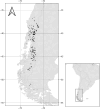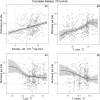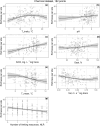Biogeographical patterns of species richness in stream diatoms from southwestern South America
- PMID: 38510542
- PMCID: PMC10954374
- DOI: 10.1002/ece3.11156
Biogeographical patterns of species richness in stream diatoms from southwestern South America
Abstract
The latitudinal diversity gradient (LDG) hypothesis has been validated for many taxon groups, but so far, stream diatoms have not conformed to this pattern. Research on diatoms that includes data from South America is lacking, and our study aims to address this knowledge gap. Previous studies have successfully explained stream diatom species richness by considering niche dimensionality of physicochemical variables. Moreover, in southwestern South America, the observed biogeographical pattern differs from LDG and has been shown to be determined by historical factors. We used a dataset comprising 373 records of stream diatom communities located between 35° S and 52° S latitude, southwestern South America. The dataset included physicochemical river water variables, climate data, and ice sheet cover from the Last Glacial Maximum. We explored geographical patterns of diatom species richness and evaluated 12 different causal mechanisms, including climate-related theories, physicochemical and climatical exploratory analyses, historical factors, and niche dimensionality. A metacommunity analysis was conducted to evaluate the possible nested structure due to historical factors. We observed an increase in diatom species richness from south to north. Models containing both physicochemical and climatic predictors explained the highest proportion of variation in the data. Silica, which was correlated with latitude, and flow velocity, which did not show any spatial pattern, were the most important predictors. Historical factors and nested structure did not play any role. Contrary to what has been reported in the literature, we found no support for climate-related explanations of species richness. Instead, theories related to niche dimensionality and local factors provided better explanations, consistent with previous related research. We suggest that the increase in diatom richness in the north of our study region is due to a higher nutrient supply in these rivers, rather than a due to larger species pool in the area.
Keywords: Clementsian structure; Glasonian structure; PATICE; flow velocity; latitudinal diversity gradient; number of limiting resources; silica.
© 2024 The Authors. Ecology and Evolution published by John Wiley & Sons Ltd.
Conflict of interest statement
The authors declare no conflicting interests.
Figures





References
-
- APHA . (2005). Standard methods for the examination of water and wastewater (21st ed.). American Wastewater Association and Water Environment Federation.
-
- Archibald, F. (1983). Lactobacillus plantarum, an organism not requiring iron. FEMS Microbiology Letters, 19(1), 29–32.
-
- Armesto, J. J. , Manuschevich, D. , Mora, A. , Smith‐Ramirez, C. , Rozzi, R. , Abarzúa, A. M. , & Marquet, P. A. (2010). From the Holocene to the Anthropocene: A historical framework for land cover change in southwestern South America in the past 15,000 years. Land Use Policy, 27(2), 148–160. 10.1016/j.landusepol.2009.07.006 - DOI
-
- Balech, E. , & Ferrando, H. J. (1964). Fitoplancton marino. Editorial Universitaria de Buenos Aires.
LinkOut - more resources
Full Text Sources
Miscellaneous

